Carol Fenster's Blog, page 20
December 2, 2013
Cranberry Shortbread Bars for the Holidays
Every holiday season, I walk into my favorite coffee shop (the one with a store on every corner!!!) and salivate over the cranberry bars. I named them “Cranberry Shortbread Bars” since they’re based on my shortbread crust.
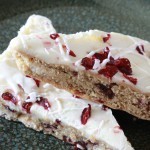
Gluten-free Cranberry Shortbread Bars
Since I can’t even try them (they are definitely not gluten-free!), I rely on descriptions from family and friends to guide me in the kitchen. These bars call out to me every year, so I just had to develop my own version and it appears in my book 1,000 Gluten-Free Recipes. Enjoy!
Cranberry Shortbread Bars
Adapted with permission from 1,000 Gluten-Free Recipes by Carol Fenster (Wiley, now Houghton Mifflin Harcourt, 2008)
These bars contain all the flavors I love: cranberries, ginger, white chocolate, and orange, so it’s no secret that I covet them every year when I see them in coffee shops. For each dairy-laden ingredient, I offer a substitute but I have a hard time finding gluten-free/dairy-free white chocolate chips so you can use semi-sweet chocolate but the taste will be slightly different.
CRUST
¼ cup (½ stick) unsalted butter or buttery spread
¼ cup packed light brown sugar
1 teaspoon grated orange zest
1 teaspoon pure vanilla extract
1 cup Carol’s Flour Blend (see below)
1 teaspoon xanthan gum
½ teaspoon ground ginger or 1 tablespoon very finely chopped candied ginger
½ teaspoon salt
1 large egg yolk
¼ cup dried sweetened cranberries, chopped
¼ cup gluten-free white chocolate chips or finely chopped chocolate chunks
Frosting
1 small package (3 ounces) low-calorie cream cheese or cream cheese alternative, at room temperature
½ cup powdered sugar
1 teaspoon orange extract
1 teaspoon pure vanilla extract or ¼ teaspoon vanilla powder
1 teaspoon fresh lemon juice
2 tablespoons chopped dried sweetened cranberries
DRIZZLE
½ cup powdered sugar
1 teaspoon fresh lemon juice
1 teaspoon canola oil and enough water to form thin frosting
Per bar: 140 calories; 1g protein; 6g total fat; 1g fiber; 4g saturated fat; 21g carbohydrates; 25 mgs cholesterol; 101 mgs sodium
[1] Preheat oven to 325°F. Lightly grease 9-inch nonstick pan.
[2] Make the crust: In food processor, combine butter, brown sugar, orange zest, and vanilla and process until smooth. Add flour blend, xanthan gum, ginger, and salt and process until well blended. Scrape down sides with spatula. Add cranberries and white chocolate chips and process until blended again. With wet spatula, press batter evenly into pan.
[3] Bake 15 to 20 minutes, or just until edges start to brown. Cool bars 10 minutes in pan on wire rack.
[4] Make frosting: Blend cream cheese, powdered sugar, orange and vanilla extracts, and lemon juice until smooth. With spatula, spread frosting evenly over crust and immediately sprinkle with chopped cranberries. Chill bars at least 2 hours.
[5] Make drizzle: Combine powdered sugar, lemon juice, canola oil, and enough water to form thin frosting. Drizzle frosting in thin line back and forth across bars. Chill again 2 hours before serving. Makes 16 small bars.
Carol’s Flour Blend
1 ½ cups sorghum flour or brown rice flour
1 ½ cups potato starch
1 cup tapioca flour/starch
Whisk together all ingredients thoroughly and store, tightly covered, in a dark, dry place.
November 21, 2013
How America Does Thanksgiving…Plus Thanksgiving Hash from Leftovers
Of all the winter holidays, Thanksgiving is my favorite.

Thanksgiving turkey leftovers make a great hash
It’s about grace and gratitude, unburdened with the stress of gift-giving at Christmas or over-jealous celebrations on New Year’s Eve.
Most importantly for me, it’s all about the Thanksgiving meal ritual. We all expect the same dishes every year because we like them. Heaven help anyone who tries to change that! One year my sister-in-law thought she’d change the menu from turkey to pizza. Surprisingly, it wasn’t the adults who revolted; instead it was the kids who wanted everything to be just the same, just like last year. In other words, keep the traditions alive with the same foods.
So, I was interested to see the November issue of Food Network magazine where thousands of surveyed readers shared how they “do” Thanksgiving. How does your Thanksgiving compare to these survey results?
How Do You Prepare Your Turkey?
91% roasted (always roasted at my house)
6% fried
3% grilled
To Brine or Not to Brine the Turkey?
30% Yes (always brine my turkey)
70% No
Do You Prefer Light Meat or Dark Meat?
66% Light
34% Dark (give me a turkey leg and I’m happy)
What kind of pie?
55% pumpkin (that’s me, but I’ll also take pecan if I can get it)
25% apple
22% pecan
Average Number of Dishes Served with the Turkey?
7 sides (at my house: stuffing, sweet potato casserole, mashed potatoes, green beans, homemade cranberry sauce, and bread)
Favorite Thanksgiving Dish?
Stuffing, hands down (not me; first, turkey and then sweet potatoes, followed by pie)
What Time Do You Get Up to Start the Turkey?
Most of us get up around 6 or 7 AM to start the turkey. And, 6% get up at 4 AM.
How Do You Serve the Meal?
58% Family style at the table
42% Buffet style (for our large extended family, it has to be buffet style)
What Time Do You Serve the Meal?
4 PM is the magical hour for most of us
Whole Berry Cranberry Sauce or Jellied (from the can)?
51% whole berry (I always make my own)
49% jellied
Do You Put the Stuffing Inside or Outside the Bird?
72% Outside the bird (much easier, plus you get that crunchy, browned top)
28% Inside the bird
(And, 67% make stuffing the same way every year…meaning 33% change it up once in awhile)
It’s kind of fun to see how our families stack up against America, isn’t it. But remember—regardless of what these numbers say—you should do what your family prefers because that’s what Thanksgiving is all about… family. Happy Thanksgiving!
And, thinking ahead to all those leftovers, here is my recipe for turkey hash.
Carol Fenster’s Turkey Hash
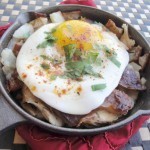
Turkey Hash from Thanksgiving leftovers
(adapted from the award-winning 1,000 Gluten-Free Recipes by Carol Fenster, Wiley, 2008)
2 tablespoons olive oil
1 tablespoons unsalted butter or buttery spread
2 cups leftover mashed potatoes (or cooked, diced potatoes or hash browns, if that’s what you have)
1 cup chopped or shredded cooked turkey (or chicken, ham, or beef)
¼ cup gluten-free chicken broth
1 tablespoon gluten-free Worcestershire sauce
1 tablespoon Dijon mustard
2 tablespoons finely diced fresh onion or 2 teaspoons dried minced onion
½ teaspoon celery salt
½ teaspoon freshly ground black pepper
4 large eggs
Additional salt and pepper
Paprika, for garnish
2 tablespoons chopped fresh parsley or 1 tablespoon dried parsley, for garnish
Additional salt and pepper, to taste
[1] In a heavy, cast-iron skillet, heat 1 tablespoon of the olive oil and the butter in a heavy, cast iron skillet over medium heat. Place the potatoes and meat in the skillet and cook until heated through.
[2] While the mixture heats, in a medium bowl, whisk together the broth, Worcestershire sauce, mustard, onion, celery salt, and pepper, in a medium bowl and pour over the potatoes and meat.
[3] With a spatula, press the mixture firmly down to compress it so all parts brown evenly; and cook until deeply browned and crispy on the bottom. Flip the hash, add the remaining tablespoon of olive oil to the skillet, and cook the other side until deeply browned and crisp. (Cooking time varies with the type of ingredients and their moisture content, so keep checking the browning process; the browner the better for crispiness and flavor.)
[4] Transfer the hash to a serving plate, season with additional salt and pepper, and cover with foil to keep warm. (Or, leave the hash in the skillet and cook the eggs in a separate skillet, which keep the hash warmer and intact so you can serve it right out of the skillet.)
[5] Add 4 whole eggs to the same skillet and fry each to the desired degree of doneness. Add salt and pepper to taste. Place eggs on top of hash and dust with paprika and parsley. Cut into wedges serve immediately. Makes 4 servings
November 14, 2013
Pizza Crust 101 Video
Carol Fenster demonstrates how to make a gluten-free pizza crust.
November 11, 2013
And the Bob’s Red Mill GF Piecrust Mix Winners Are……!!!
My, what a bunch of pie-lovers you all are!
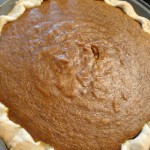
Gluten-Free Pumpkin Pie
The response to the Bob’s Red Mill piecrust giveaway was fast and I appreciate your participation!
The Three Winners Are…
The contest is officially closed and we have three lucky winners who will certainly be making pie this coming Thanksgiving:
[1] Marge R. from Pinehurst, NC
[2] Joan H. from Gresham, OR
[3] Colleen R. from Kenosha, WI
Congratulations to each of you. Bob’s Red Mill will send the pie boxes to each winner. For everyone else, check your local natural food store and if the piecrust mixes aren’t on the shelf then ask the store manager to order them for you. Hopefully, you can get them in time for Thanksgiving.
But, if you’re committed to making your own piecrust from scratch, then consult my cookbooks for recipes. And, to see how I make piecrust for a Double-Crust Cherry Pie, go to Videos on my website (www.CarolFenster.com) or blog (www.CarolFensterCooks.com) and click on the Pie Crust Video.
What’s Your Favorite Pie?
Nearly a hundred of you responded within 24 hours. I tabulated your favorite pies and here are the winners:
[1] Pumpkin, hands down favorite for 25% of you
[2] Pecan, 14%
[3] Apple, 12%
Also mentioned were Coconut Cream, Chocolate, Strawberry, Cherry, and Lemon. Also, Mincemeat, Coffee Toffee, Pineapple, Blackberry, Peach, Blueberry, Rhubarb, Plum, and French Silk. (I’m salivating as I type this luscious list of pie flavors!!)
Thank you again for your responses!
The Gluten Summit is Free, so sign up now
By the way, are you listening to the free gluten-free lectures/interviews presented by Dr. Tom O’Bryan this week? You can just sit at your computer and listen to these on-demand sessions whenever you wish. But hurry, because each interview is only available for about two days, then it’s archived and will later be for sale. For more information and to register, go to http://theglutensummit.com. The lectures are only presented from November 11 – 17, so hurry! Don’t miss this wonderful opportunity
November 9, 2013
Holiday Pies: Win Your Own Bob’s Red Mill New Gluten-Free Piecrust Mix!
Pies are wonderful any time, but they are especially important during the holidays because so many of our celebrations focus on pumpkin pie or mincemeat pie or whatever pie your family prefers!
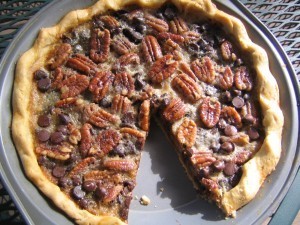
Gluten-Free Pecan Pie
My personal favorite is pecan pie (see photo) but I’m a pushover for pumpkin pie, with whipped cream and a dollop of cranberry sauce (the real stuff, not canned!).
But, it’s the piecrust that stops many of us from making our own pies. Making any piecrust can be challenging, but gluten-free piecrust can be doubly so. That’s why I’m so excited to announce a new gluten-free piecrust mix from Bob’s Red Mill. It takes the guesswork out of making perfect pies, just in time for the holidays!
Want to Win a Gluten-Free Piecrust Mix?
To celebrate this new product, Bob’s Red Mill has assembled a Pie Box

Bob's Red Mill Gluten-Free Pie Box
, complete with two packages of piecrust mix, a pie server, and a small recipe booklet (see photo). They will give away a pie box to three lucky winners.
Want to be a lucky winner? By Friday, November 15, just send an email to me at carol@carolfenster.com and tell me your favorite pie, plus be sure to give me your postal mailing address in case you’re a winner. Bob’s Red Mill will mail you the pie box, it’s that simple.
So, send me an email at carol@carolfenster.com and maybe you’ll be a winner!
November 4, 2013
Gluten-Free Thanksgiving Menu Planner E-Book at Amazon.com
Can you believe it is November already and Thanksgiving is just around the corner?
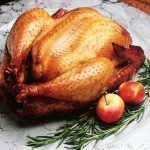
Thanksgiving Turkey
It is probably the holiday that I get the most questions about because so many of the traditional foods—dinner rolls, stuffing, gravy, pies and other desserts—are wheat-based. And, for non-gluten-free folks, it can be stressful when trying to cook safely for gluten-free guests.
So, my partners at GfreeCuisine.com and I wrote the Gluten-Free Thanksgiving Menu Planner that you can buy as an e-book at Amazon.com for only $2.99.
The 59-page e-book contains delicious, simple gluten free recipes that make Thanksgiving memorable. It also includes a grocery list, planning guide, and life-saving Thanksgiving tips that will prevent turkey trauma—especially if you are new to the gluten-free lifestyle and apprehensive about cooking on the big day.
I know that it is hard to please everyone because people have preconceived notions about the Thanksgiving menu and how it should taste. So, the recipes in this e-cookbook are the classics—but revised with gluten-free ingredients that look and taste like old favorites. And, because the flavors taste familiar, everyone is happy—even if they’re not gluten-free.
Recipes include appetizer, turkey, gravy, stuffing, sweet potato casserole, mashed potatoes, cranberry sauce, green beans, dinner rolls, and a pumpkin trifle dessert that is perfect for entertaining and very simple to make so you don’t have to fuss with a piecrust.
Also, some turkeys can be injected with solutions that could contain wheat, so buy a fresh one like I do and brine it for the most wonderful flavor. We tell you how to do it.
The e-book also gives you a time-plan, day by day, so you know what to do before and on the big day to make the meal come together beautifully and make you the perfect host.
The Gluten-Free Thanksgiving Menu Planner is offered by me and GfreeCuisine, a weekly recipe and menu-planning service that helps gluten-free families decide what to prepare for dinner during the coming week. Each Thursday, 10 new menus (with side-dish selections) are available to subscribers, who pay $10 per month. Subscribers choose 5 of the menus (one for each weeknight) and print out a customized grocery list, based on the 5 menus they selected. The grocery list is organized by sections of the grocery store, making shopping much more efficient. All dishes are gluten-free and dairy-free and several are kid-friendly and vegetarian, as well. Recipes for a wide array of desserts and breads are also provided for subscribers.
October 30, 2013
Roasted Vegetables for Marvelous Flavor
The days are crisp here in Colorado and temperatures fall to below freezing at night—the perfect time for oven-cooked meals. One of my favorites is roasted vegetables.
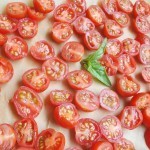
Tomatoes Ready for Roasting in the Oven
I didn’t fully understand how vegetables are transformed with this method of cooking until a few years ago when I (successfully) roasted cauliflower (dusted with curry powder) to get my husband to eat it. Then I tried Brussels sprouts (at least I liked them, with a little bacon and vinegar…hubby didn’t) and found that lots of other vegetables roasted well, such as broccoli, asparagus, carrots, fennel, tomatoes,….and more.
What’s happening here? Experts say that roasting heightens flavor because the oven’s heat caramelizes the sugars in the vegetables, mellowing any strong overtones. I think roasting also dries out the vegetable a bit by reduced the moisture content, thereby increasing the ratio of flavor to the veggie’s volume. The secret to roasted vegetables is to use a high-temperature oven and to roast the vegetables on the upper racks of the oven.
Is there a recipe for roasted vegetables? I developed several versions for my books , so I’m reprinting one of them here to give you some guidance. Enjoy!!
Roasted Carrots and Parsnips in Sage Butter
Adapted from 125 Gluten-Free Vegetarian Recipes by Carol Fenster (Avery/Penguin Group, 2011)
Traveling in Europe, I observed that parsnips are far more popular there. I hope this recipe convinces you to give them a try. If yours are especially large, slice away the core, which tends to be woody. Both carrots and parsnips become much sweeter when roasted. I’ve even eaten roasted parsnips for breakfast at a world-famous spa, so feel free to serve them at any meal.
1/2 pound parsnips, peeled and thinly sliced lengthwise in 1/4-inch strips
1/2 pound carrots, peeled, and thinly sliced lengthwise in 1/4-inch strips
1 tablespoon extra-virgin olive oil
1/2 teaspoon sea salt
1/4 teaspoon freshly ground black pepper
1 ½ tablespoons unsalted butter or buttery spread
10 sage leaves, chopped, or 1/2 teaspoon dried, plus extra for garnish
{1] Place a rack in the upper-third of the oven. Preheat the oven to 425 degrees. Line a 9×13-inch baking sheet (not nonstick) with parchment paper.
[2] In a large bowl, toss the parsnips and carrots with the olive oil until well coated. Add the salt and pepper and toss to coat thoroughly, then arrange in a single layer on the baking sheet.
[3] Roast until tender and lightly browned, about 20 to 25 minutes.
[4] While the vegetables roast, melt the butter in a small saucepan over medium heat. Add the sage and cook just until the sage is slightly crispy, being careful not to burn the butter.
[5] Transfer the vegetables to a serving bowl and drizzle the sage-butter mixture over the vegetables and toss gently to coat thoroughly. Garnish with remaining sage leaves and serve hot. Serves 4.
Calories 130; Fat 8g; Protein 1g; Carbohydrates 14g; Cholesterol 12 mg; Sodium 258mg; Fiber 4g
October 21, 2013
Substitutes for Eggs in Gluten-Free Baking
Fall is here and the holidays are just around the corner, so many of us are doing more baking these days.

Chocolate Cupcakes can be made egg-free.
If eggs are not a problem at your house, you probably use them without even thinking about it. But if you have egg allergies or intolerances, baking without eggs is a real challenge. In fact, I would rather give up wheat flour than eggs when it comes to baking!
But over the years, I’ve learned how to use ingredient substitutes for eggs, so here’s a quick look at what I’ve learned. A few of my books contain recipes for baking without eggs Cooking Free and 125 Gluten-Free Vegetarian Recipes so you really need those books for the recipes and more explanation and hints because each substitute has advantages and disadvantages. But here are the highlights:
Why Are Eggs So Important?
Eggs are one of the hardest ingredients to make substitutions for because they play such critical––and varied––roles in baking. They can be used as binding agents (hold ingredients together), moisturizers (add moisture), or as leavening agents (make things rise) in baking.
And, it gets more complicated.
Egg yolks and egg whites play separate roles in baking. The lecithin in egg yolks emulsifies ingredients, that is, it blends ingredients together that would not ordinarily blend––such as oil and water––and produces smooth, creamy textures.
Egg whites, on the other hand, are the actual leavening component of eggs. They make soufflés or angel food cakes light and airy. Knowing all this, you can see why the standard “fix” in gluten-free baking is to add another egg to the recipe!
Eggs as Binders and Moisturizers
If the recipe has only one egg but contains leavening––such as baking powder or baking soda––then the egg is the binder. If there is no other liquid, then the egg is the binder AND the moisturizer.
I’ve tried several egg substitutes, but my favorite egg-free binder/moisturizer is soft silken tofu or flax seed––with puréed fruits such as applesauce, bananas, or prunes my next favorite. Tofu (soft, silken) makes baked goods moist, with an appealing, though somewhat dense texture. The natural pectins in fruits, especially prunes, trap air which helps “lighten” baked goods.
In place of 1 large egg as a binder and/or moisturizer, use:
*Soft Silken Tofu (Mori-NuÒ): Use ¼ cup and blend with recipe liquid until completely smooth before adding dry ingredients.
* Flaxseed: (available as brown or golden seeds which you pulverize in a small coffee/spice grinder first or start with ground flaxmeal): Use ¼ cup for each large egg. Combine 1 teaspoon ground flaxseed with ¼ cup boiling water. Let stand 5 minutes to thicken and cool slightly. Refrigerate flax to avoid rancidity.
*Pureed Fruits and Vegetables: (Applesauce, bananas, prunes, apricots, pears, carrots, and corn.) Use 3 Tbsp.
Increase liquid in recipe by 1 Tbsp.
Eggs as Leavening Agents
If there are no other ingredients that make the baked item rise (yeast, baking soda, baking powder), then the egg is the leavening agent. Baked goods that rely on egg whites to make them rise––such as angel food cakes or soufflés––do not work well with egg substitutes.
In place of 1 egg as a leavening agent, use:
*Egg Replacer Powder (Ener-G or Kingsmill): Whisk 1 Tbsp. into 2 Tbsp. water until smooth.
*Buttermilk-Soda: Replace liquid in recipe with same amount of buttermilk (or thinned yogurt or cultured coconut milk). Replace baking powder with one-quarter as much baking soda (e.g., ¼ teaspoon baking soda for each 1 teaspoon baking powder.)
Also, try these additional tips:
[1] Add air in two ways to make the recipe lighter and less dense:
-a. Cream fat and sugar together with electric mixer. Then add dry ingredients, or,
-b. Whip liquid ingredients in blender for 30 seconds to incorporate air into recipe.
[2] Add an extra 1/2 teaspoon baking powder per egg. Do not exceed 1 teaspoon baking powder per cup of flour or a bitter taste develops and you can over-leaven a recipe, causing it to fall.
[3] Choose recipes with acidic liquids such as buttermilk, molasses, lemon juice, or vinegar since they tend to rise better than those with non-acidic liquids such as water or milk.
One final note: Check with your physician to make sure egg substitutes are acceptable for your diet. And, you are allergic or intolerant to eggs should also avoid products such as Egg-Beaters® because they still contain eggs (usually just the whites), but possibly other food culprits, as well.
October 15, 2013
Substituting for Large Eggs in Baking

Large eggs are the industry standard for baking.
Today, I want to talk about substituting for large eggs, the industry standard in baking. But first, have you ever wondered how prehistoric man discovered eggs?
Yes, I have pondered this question.
WHO DISCOVERED EGGS IN THE FIRST PLACE?
Some people contemplate the weighty issue of which came first: the chicken or the egg. Not me. I focus on the more profound issue of how mankind discovered the wonders of the egg in the first place. How did “they” know that one could eat the oval object that fell from what I presume was some sort of feathered creature? Did a Neanderthal Julia Child accidentally kick a few into the fire, then make egg salad sandwiches for her bridge club? How did a Stone-Age Emeril figure out that eggs were critical to baking?
We will never know the answers to such these serious culinary questions, but one thing is for sure. Eggs do wonderful things for our gluten-free baking. Consequently, I’m often asked how to use different-size eggs. Even though large eggs are the accepted standard in American recipes, you may find that your supermarket has extra-large eggs on sale one week and then jumbo eggs on sale next week. Wanting to take advantage of these savings, you buy them and then wonder if/how you can use them.
SOME GUIDELINES FOR USING DIFFERENT-SIZE EGGS
In non-baking recipes, such as scrambled eggs, you can safely assume that one egg equals one egg and you won’t notice the small difference in size. Hard-boiled eggs make take a little longer to cook if they’re extra-large or jumbo.
In baking, the answer is yes, you can use extra-large and jumbo eggs instead of large, with a few adjustments.
Here is a handy chart that you can use to guide you:
If a recipe calls for one or two large eggs, use the same number of extra-large or jumbo eggs.
But:
–if a recipe calls for 3 large eggs, use 3 extra-large or 2 jumbo eggs
–if a recipe calls for 4 large eggs, use 4 extra-large or 3 jumbo eggs
–if a recipe calls for 5 large eggs, use 4 extra-large or 4 jumbo eggs
–if a recipe calls for 6 large eggs, use 5 extra-large or 5 jumbo eggs
With colder weather upon us, and the holidays just around the corner I’m sure you’ll be baking more so hopefully these egg guidelines will come in handy in the coming weeks.
Happy Baking!
October 8, 2013
Foodie Literature for a Good Read
What do you like to read?
I am an avid reader, devouring at least a book a week and sometimes—when I spend lots of time in airplanes and airports—it’s several a week. My tastes are eclectic, but many of the books on my Kindle involve food. In fact, I love a “foodie who-dun-it” or “culinary mystery” as they’re called and especially like those that contain recipes, although that’s not a prerequisite (since they’re never gluten-free anyway!) Just a good story—involving food as the focus or background— intrigues me.
Right now, I’m reading The Telling Room: A Tale of Love, Betrayal, Revenge, and the World’s Greatest Piece of Cheese by Michael Paterniti. Set in Spain, it’s about a Spanish family’s homestyle cheese that gains world-wide acclaim—but not without difficulties—and the Michigan-based journalist who brings the story to life. No recipes, but plenty of drama.
Recently, I read The Whole Enchilada, by fellow Coloradoan Diane Mott Davidson. One of several (I’ve read them all) in her series about caterer Goldy Schulz, this story involves the murder of her friend. So, Goldy sets out to solve the crime, with many endearing mishaps along the way. And, as usual, a few recipes for her readers. None are gluten-free, but could be adapted.
Once I find a book I like, I look for others by the same author. About a year ago, I discovered a series of 10 novels called The Coffeehouse Mysteries set in The Village, a coffeeshop in Greenwich Village. It involves Clare Cosi, who co-owns the coffeeshop with her ex-husband because his wealthy mother started the coffeeshop decades ago and wants it to survive (and perhaps see the two exes reunite?). Clare solves murders, and there is always coffee brewing in the background (I can almost smell it, coffee-lover that I am) and finally, there are recipes that Clare serves her policeman-boyfriend (and yes, that further complicates the plot). Coming in December is Billionaire Blend; can’t wait.
Sometimes, I find authors I like and then try to read all of their books. Such was the case with Mark Kurlansky, who has written books on Salt: A World History; Cod: A Biography of the Fish that Changed the World; The Big Oyster: History on the Half Shell. These are not novels, but non-fiction books that expand my knowledge about the food world. The one I enjoyed the most was Birdseye: The Adventures of a Curious Man, about the man (Clarence Birdseye) behind Birdseye frozen foods. Believe it or not, the invention of frozen food wasn’t all that long ago.
Of course, I love anything written by Michael Pollan, because I learn so much from him. His Cooked: A Natural History of Transformation was fascinating and I love his style of writing. But also try The Omnivore’s Dilemma, In Defense of Food, and Food Rules to learn more about our food supply. You will be shocked at some of the things you will learn. And, Salt, Sugar, Fat by Michael Moss was an eye-opener.
Then there’s the White House Chef Mystery series by July Hyzy whose novels feature White House Chef Ollie Paras, so the plots involve political fun and always a few recipes. The latest one I read was Buffalo West Wing (and yes, the plot involves Buffalo wings).
I also like food memoirs; the latest one to find its way to my Kindle was One Souffle at a Time: A Memoir of Food and France by the legendary Anne Willan who started LaVarenne Cooking School in France. Anne is very well-known in the culinary world and she’s led an interesting life; of course, French-inspired recipes are in the book.
Other food memoirs that I’ve read in the past year include the following;
Licking the Spoon: A Memoir of Food, Family, and Identity by Candace Walsh
Blue Plate Special: An Autobiography of My Appetites by Kate Christensen
The Cassoulet Saved Our Marriage: True Tales of Food, Family, and How We Learn to Eat by Caroline M Grant, and Lisa Catherine Harper
Poor Man’s Feast by Elissa Altman
CookFight: 2 Cooks, 12 Challenges, 125 Recipes, an Epic Battle for Kitchen Dominance, by Julia Moskin and Kim Severson
Yes, Chef, by Marcus Samuelsson and Veronica Chambers
I could go on and on, but this gives you an idea of the vast array of books that can entertain and delight us, with food as either the focus or background. You don’t have to read them on Kindle like I do; holding a real book in your hands has its merits. Whatever format you choose, maybe these books would make a good gift for yourself or someone who likes food. Enjoy!



